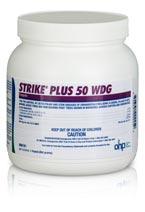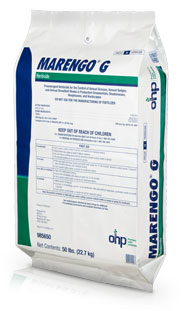OHP introduces Strike® Plus Fungicide
September 27, 2013
OHP, Inc. is pleased to announce the immediate availability of Strike Plus Fungicide to the production  ornamentals market through authorized distributors.
ornamentals market through authorized distributors.
Strike Plus contains two active ingredients for dual modes of action (MOA), giving more broad-spectrum control of troublesome foliar diseases.
“Strike Plus is a broad-spectrum fungicide that can be used both inside and outside and as preventive or curative. The user simply adjusts the rate accordingly,” notes Dr. Carlos Bográn, OHP technical manager.
The product contains triadimefon, the active ingredient in Strike® 50 WDG fungicide, plus trifloxystrobin, the active ingredient in Compass® O fungicide.
With the combination of a sterol inhibitor (triadimefon) and a strobilurin (trifloxystrobin), Strike Plus provides comprehensive control of many diseases including powdery mildew, rusts, anthracnose, leaf spots, botrytis, boxwood blight, and others.
The combination lessens the high resistance potential that users may face when repeatedly using a strobilurin fungicide by itself.
“If resistance to strobilurin chemistry is an issue, growers can mitigate that with the use of Strike Plus,” notes Bográn. “It’s a good fit into a resistance management rotation.”
OHP will phase out Strike 50 WDG but will maintain federal and state registrations for a period of time so growers can use up existing stock.
OHP is a leading marketer of pest and weed control solutions to the production ornamentals market. For more information on Strike Plus, click here.
OHP introduces granular Marengo herbicide
September 16, 2013
OHP, Inc. has followed up its successful launch of Marengo® liquid pre-emergent herbicide with the introduction of Marengo G, a granular formulation with the same effective active ingredient, indaziflam.
introduction of Marengo G, a granular formulation with the same effective active ingredient, indaziflam.
Marengo G offers production ornamental growers many of the same features as Marengo SC including consistent plant safety, broad-spectrum weed control, and long-term residual.
The Marengo G label allows for application to containers in nurseries, and hoop and shade houses.
“We’re pleased to introduce a granular version of Marengo to the market after the successful launch of Marengo liquid,” notes Terry Higgins, OHP vice president and general manager. “Marengo G features all the benefits of indaziflam in an easy-to-apply granular formulation for over-the-top applications.”
Marengo G offers effective, long-term selective pre-emergent control of both broadleaf and grassy weeds with little effect on desirable plant species. The product does not volatilize and does not move in soil once watered-in after application.
“With the new formulation, growers in container and field nurseries may now use the product for over-the-top applications,” says Dan Stahl, OHP vice president of marketing and business development.
Marengo contains the first active ingredient from MOA (Mode of Action) Group 29. The active ingredient prevents weed seed germination by inhibiting cellulose biosynthesis.
California and New York state registrations are pending.
OHP is a leading marketer of pest and weed control solutions to the production ornamentals market. For more information on Marengo G, please visit http://www.ohp.com/Products/marengo_g.php
OHP re-launches Terraclor® 400 ornamental fungicide
April 20, 2013
OHP, Inc. announces the re-launch of Terraclor® 400 Ornamental Fungicide for users in greenhouses, nurseries, and shadehouses.
In addition, Terraclor 400 may be used on landscape and field grown ornamentals.
The economical liquid fungicide is widely used for control of tough diseases such as rhizoctonia, sclerontinia, and phyllostica.
Terraclor 400 can be sprayed, drenched, or used as a bulb soak on a variety of woody plants, bedding plants, bulb crops such as gladiolas, hyacinths, iris, tulips, and lilies. Terraclor 400 can be used on Southern Magnolia Trees for control of phyllostica cookeri.
The product may also be used as a soil drench on vegetable bedding plants grown in containers or beds including tomatoes, peppers, broccoli, and cabbage for control of rhizoctonia solani prior to transplanting in the field.
Terraclor 400 carries a 12-hour REI and a Caution signal word.
State registrations are pending and for more information click here.
OHP Inc. is a leading marketer of pest solutions to the production ornamental industry.
Floramite® Miticide now offered in new 8 fl.oz. package
April 20, 2013
We are pleased to announce the immediate availability of Floramite® SC/LS Miticide in a new 8 fl. oz. package.
The new convenient packaging is ideal for the small landscaper or grower and offers a significant profit opportunity for distribution.
Floramite, the leading miticide in the ornamental market, offers fast and thorough control of many types of mites including two-spotted spider mites, spruce spider mites, and Lewis mites. It is extremely soft on beneficial and predatory insects.
We thank you for your support of the introduction of Floramite SC/LS in the 8 fl. oz. size. Please contact your local OHP Regional Sales Manager here for more information.
Prevention and Management of Boxwood Blight
January 28, 2013
by Kelly Ivors, Extension Plant Pathologist, Dept. of Plant Pathology, NC State University
This disease can significantly impact the appearance and aesthetics of boxwood because the foliage typically becomes blighted and drops from the plant. Symptoms of box blight include: dark‐ or light‐brown, circular leaf spots often with darker margins; dark stem cankers or black ‘streaks’ on stems; straw‐ to bronze‐ colored, blighted foliage; and leaf drop. Leaf spots may grow together to eventually cover the entire leaf (see pictures). In container boxwood, sometimes only the lower foliage and stems become infected, leaving the tops green and making the plant appear top‐heavy.On large field‐grown or landscape plants only one section of the plant closest to the ground on the shaded side will be blighted.
…full article found here.
Photos of Boxwood Blight found here.